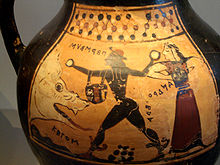San (letter)
The San ( uppercase Ϻ, minuscule ϻ) is a letter that appeared in some pre-classical variants of the Greek alphabet . Outwardly it resembles an M. The San usually had the sound value / s /, but was given up early on in favor of the letter sigma . The last recorded use dates from the 5th century BC. Chr.
origin
The San is derived from the Phoenician Sade ( ![]() ), which denoted the emphatic s sound. This sound did not occur in Greek, which is why the sound value / s / was assigned to the San, as well as the sigma , which goes back to the Phoenician shin . In the alphabetical order, the San is in the same place as the Sade in the Phoenician alphabet, namely between Pi and Qoppa .
), which denoted the emphatic s sound. This sound did not occur in Greek, which is why the sound value / s / was assigned to the San, as well as the sigma , which goes back to the Phoenician shin . In the alphabetical order, the San is in the same place as the Sade in the Phoenician alphabet, namely between Pi and Qoppa .
The shape of the San is very reminiscent of the letter My (Μ). However, in the early variants of the Greek alphabet, similar to the Phoenician meme ( ![]() ), it was common to write My with only one vertical line, so that a distinction between My and San was ensured.
), it was common to write My with only one vertical line, so that a distinction between My and San was ensured.
use

With the San and the Sigma there were two letters for the sound value / s /. In Abecedariums (lists of all letters of the alphabet) were until the 6th century BC. Mostly both letters listed. Inscriptions, on the other hand, always used only one of the two letters. In most regions of Greece it was the Sigma, in Corinth and Crete the San. The longest, until the 5th century BC. The San remained in use in Crete until the local variant of the Greek script was replaced by the Milesian alphabet.
In scientific text editions, the San is mostly replaced by Sigma because there is no need to differentiate. In a sense, San and Sigma are seen as different glyphs of the same character.
The Arcadian-Cypriot Greek plays a special role . There, the San stands in place of an earlier labiovellar in front of a front vowel and corresponds to a rope in classical Attic . The sound value should have been / ts /.
Even after the abolition of the letter, the name San lived on among the Dorians as an alternative name for the sigma. Evidence for this can be found in Herodotus , for example , who writes in his histories that the names of the Persians "all end with the same letter that the Dorians call San , the Ionians Sigma ". According to the tradition of Athenaeus , the name of the sophist Thrasymachus was spelled in an epigram on his grave in Chalcedon with Theta Rho Alpha San Y My Alpha Chei Ou San .
Further developments
The origin of the Sampi ( Ϡ ), another pre-classical letter that was used in some inscriptions instead of a double sigma, is unclear. It could possibly be a further development of the San. The only descendant of the Greek alphabet that adopted the San is the old Italian alphabet used by the Etruscans , among others . There the letter had the form ? and the name she .
Web links
- Thesaurus Linguae Graecae tlg.uci.edu (English)

